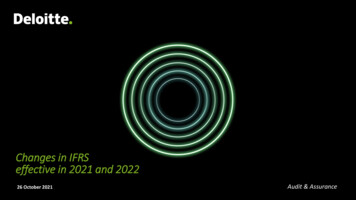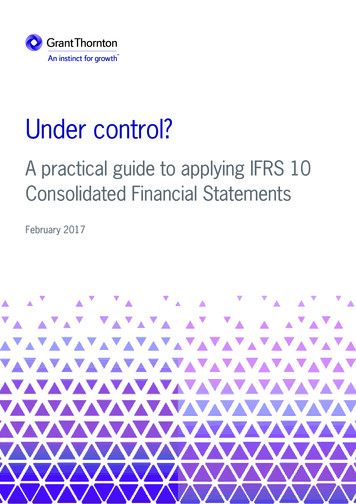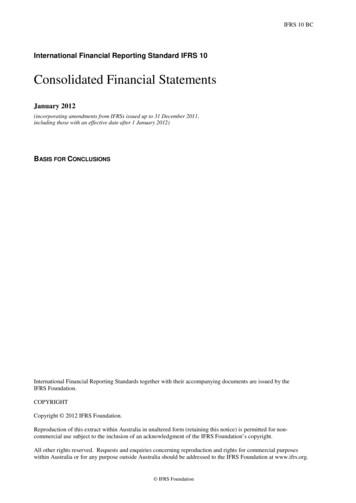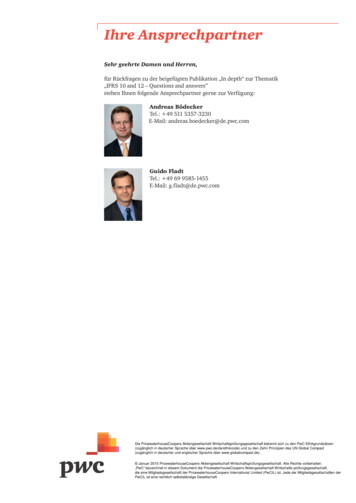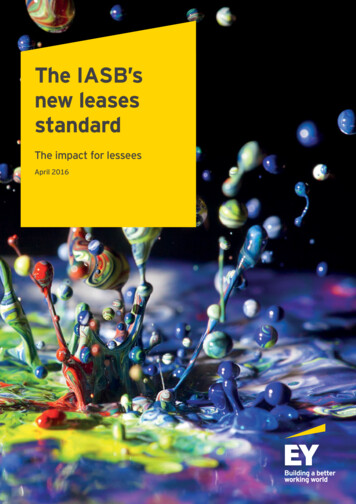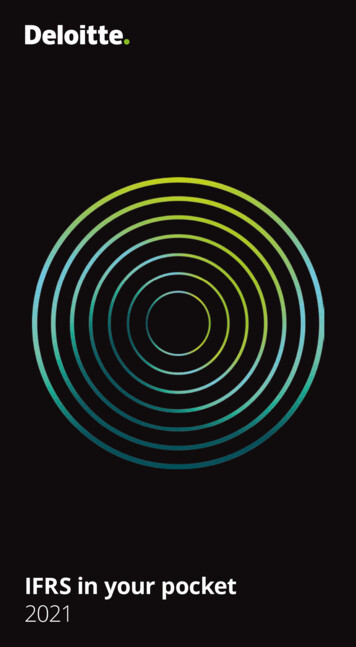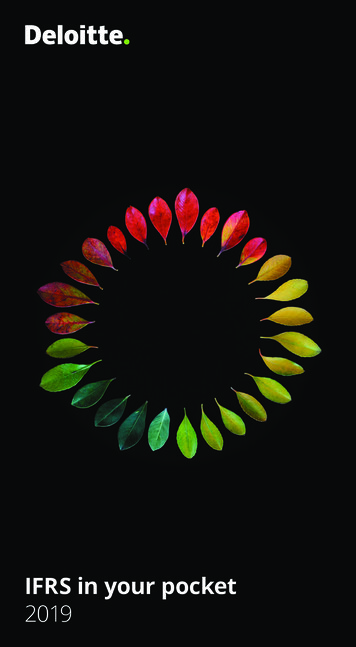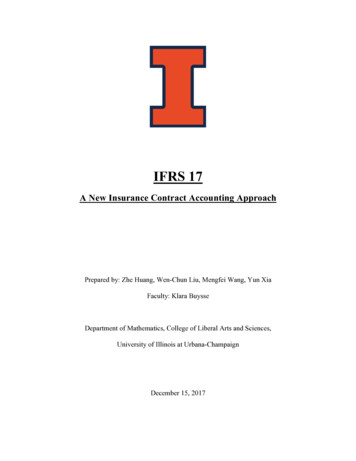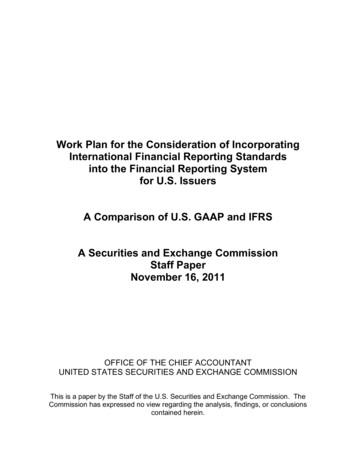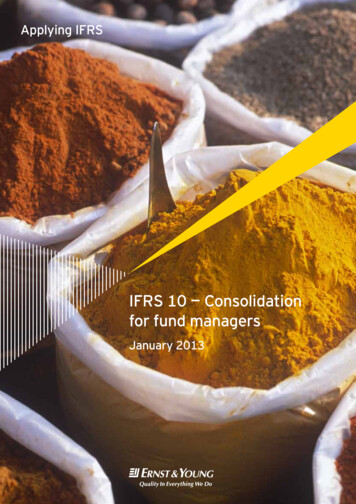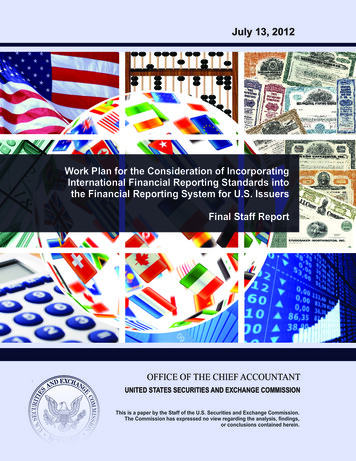
Transcription
July 13, 2012Work Plan for the Consideration of IncorporatingInternational Financial Reporting Standards intothe Financial Reporting System for U.S. IssuersFinal Staff ReportOFFICE OF THE CHIEF ACCOUNTANTUNITED STATES SECURITIES AND EXCHANGE COMMISSIONThis is a paper by the Staff of the U.S. Securities and Exchange Commission.The Commission has expressed no view regarding the analysis, findings,or conclusions contained herein.
Introductory NoteThe following report was prepared by the staff of the U.S. Securities and ExchangeCommission to summarize the observations and analyses of the staff regarding six key areasidentified for study in the Work Plan for global accounting standards. The Commission directedthe staff to develop and execute the Work Plan in February 2010. At that time, the Commissionissued a statement indicating that the information obtained through the Work Plan, among otherconsiderations, would aid the Commission in evaluating the implications of incorporatingInternational Financial Reporting Standards into the financial reporting system for U.S. issuers.The Commission believes it is important to make clear that publication of the StaffReport at this time does not imply—and should not be construed to imply—that the Commissionhas made any policy decision as to whether International Financial Reporting Standards shouldbe incorporated into the financial reporting system for U.S. issuers, or how any suchincorporation, if it were to occur, should be implemented.Although the Staff Report is constructive and an important contribution, the Work Plandid not set out to answer the fundamental question of whether transitioning to IFRS is in the bestinterests of the U.S. securities markets generally and U.S. investors specifically. Additionalanalysis and consideration of this threshold policy question is necessary before any decision bythe Commission concerning the incorporation of IFRS into the financial reporting system forU.S. issuers can occur.The Staff Report has not been approved by Commission action and does not necessarilyreflect the views of the Commission or any Commissioner.
Work Plan for the Consideration of IncorporatingInternational Financial Reporting Standardsinto the Financial Reporting Systemfor U.S. IssuersFinal Staff ReportJuly 13, 2012OFFICE OF THE CHIEF ACCOUNTANTUNITED STATES SECURITIES AND EXCHANGE COMMISSIONThis is a paper by the Staff of the U.S. Securities and Exchange Commission.The Commission has expressed no view regarding the analysis, findings, or conclusionscontained herein.
Table of ContentsI.II.Executive Summary . 1A.Methodology . 2B.Focus of the Staff’s Work . 2C.Summary Findings . 4Development of IFRS . 42.Interpretive Process. 43.IASB’s Use of National Standard Setters . 54.Global Application and Enforcement . 55.Governance of the IASB. 56.Status of Funding . 67.Investor Understanding. 6Sufficient Development and Application of IFRS for the U.S. Domestic ReportingSystem. 7A.Summary Observations . 7B.Comprehensiveness of IFRS . 8C.D.III.1.1.The Boards’ MoU and Other Joint Projects. 102.Standards with a Similar Objective, that Are Substantially Converged,or Both . 133.Fundamental Differences . 144.Industry Guidance. 17Comparability Within and Across Jurisdictions . 211.Staff Analysis of IFRS in Practice . 222.Formal Interpretative Process . 25Auditability and Enforceability. 251.Principles versus Rules . 272.Effect of Audit Firm Structure on Comparability . 283.Enforcement and Compliance . 294.International and Other Regulatory Bodies . 32Independent Standard Setting for the Benefit of Investors . 34A.Summary Observations . 35B.Overview of the IASB’s Governance Structure. 36C.Background on IFRS Foundation Trustee and Monitoring Board Reviews . 371.Trustees’ Strategy Review . 37i
2.D.E.F.G.IV.Monitoring Board’s Governance Review . 38Oversight of the IFRS Foundation . 391.Current State of Governance Structure . 392.Composition of the Monitoring Board. 403.Monitoring Board Observers . 404.Role of Application of IFRS and Funding in Monitoring BoardMembership . 415.Role of the Monitoring Board in Selection of Trustees . 426.Role of the Monitoring Board in the IASB’s Standard-Setting Process. 44Composition of the IFRS Foundation and the IASB . 451.IFRS Foundation Trustee Composition and Duties . 452.IFRS Foundation Trustee Selection Process . 473.Trustee Involvement in the Standard-Setting Process . 474.Composition of the IASB. 50Funding of the IFRS Foundation . 521.Four Characteristics of a Funding Approach . 522.Funding of the FASB . 543.Monitoring Board Role in Funding. 554.Approaches in Other Jurisdictions to Contribute to the IFRSFoundation . 565.Contributions by the Large Accounting Firms . 576.Funding from the United States . 58IASB Standard-Setting Process . 581.Focus of the Staff’s Review. 582.IASB’s Standard-Setting Process . 593.Pre-eminence of Investors — IASB’s Interaction with Investors . 614.Timeliness . 635.Objectivity. 666.Observations on IASB’s Standard-Setting Process . 68Investor Understanding and Education Regarding IFRS . 71A.Summary Observations . 72B.Current Awareness and Knowledge of IFRS. 74C.Investor Education Regarding Accounting Standards and Changes inAccounting Standards . 75D.Investor Preparedness for Incorporation of IFRS . 76ii
E.V.Current Preparedness . 762.Necessary Time and Activities Needed by Investors in Order toTransition Successfully to IFRS . 773.Investor Preferences with Regard to Transition. 78Other Investor Views . 791.Global Accounting Standards . 792.Ongoing Role of the FASB. 80Regulatory Environment . 82A.Summary Observations . 83B.Manner in which the SEC Fulfills its Mission. 84C.VI.1.1.Ongoing Role of the FASB. 842.Analysis of Changes to the Commission’s Rules and Guidance . 883.Analysis of Changes to Commission’s Ability to Issue, Interpret, orEnforce Accounting Standards . 89Industry Regulators. 891.Regulators Currently Tend to Use U.S. GAAP . 902.Commission Incorporation of IFRS Would Impact Regulators . 903.Regulators’ Impressions of IFRS . 92D.Federal and State Tax Impacts. 93E.Statutory Dividend and Stock Repurchase Restrictions . 95F.Audit Regulation and Standard Setting. 96G.Broker-Dealer and Investment Company Reporting . 97H.Public versus Private Companies. 99Impact on Issuers . 103A.Summary Observations . 104B.Accounting Systems, Controls, and Procedures . 104C.D.E.1.Systems, Controls, and Procedures . 1062.Stable Platform. 108Contractual Arrangements . 1091.Types and Pervasiveness. 1092.Effects on Issuers . 110Corporate Governance and Other Regulatory Compliance . 1131.Corporate Governance . 1132.Other Effects . 115Accounting for Litigation Contingencies. 116iii
F.VII.Smaller Issuers versus Larger Issuers . 118Human Capital Readiness . 121A.Summary Observations . 121B.Education and Training. 122C.Auditor Capacity. 123Appendix A, Exhibits A – I . 127iv
I.Executive SummaryIn the Commission Statement in Support of Convergence and Global AccountingStandards,1 the U.S. Securities and Exchange Commission (“SEC” or “Commission”) directedthe staff of the Office of the Chief Accountant of the SEC, with appropriate consultation withother Divisions and Offices of the Commission (collectively, the “Staff”), to develop and executea work plan (“Work Plan”).2 The Staff published the Work Plan in February 2010.3 Thepurpose of the Work Plan is to consider specific areas and factors relevant to a Commissiondetermination as to whether, when, and how the current financial reporting system for U.S.issuers should be transitioned to a system incorporating International Financial ReportingStandards (“IFRS”).4Since February 2010, the Staff has dedicated significant resources to executing the WorkPlan. Throughout this process, the Staff’s understanding of the potential impact and the relatedcosts and benefits of transitioning to a financial reporting system incorporating IFRS fordomestic issuers has grown significantly. However, this understanding actually began a numberof years ago and has continued in many forms.5 This final Staff paper (“Final Staff Report”)represents a summary of what the Staff has learned in the areas covered by the Work Planregarding the potential impact of any incorporation of IFRS into the financial reporting systemfor U.S. issuers. The Final Staff Report, together with such other matters as the Commissionmay consider, will inform any Commission determination on whether to incorporate IFRS andprovide transparency to the public related to the Staff’s findings and observations pursuant to theWork Plan. Regardless of the outcome of the Commission decision on whether to incorporateIFRS, the Staff expects that the SEC and other U.S. constituents will continue to be involvedwith the development or application of IFRS, or both. This involvement may take manydifferent forms including the Staff’s review of filings of foreign private issuers that prepare theirfinancial statements in accordance with IFRS, participation in International Organization ofSecurities Commissions (“IOSCO”), interactions with other securities regulators on accountingmatters, and review and commentary on the International Accounting Standards Board’s(“IASB”) standards.1See SEC Release No. 33-9109 (Feb. 24, 2010), Commission Statement of Support of Convergence and GlobalAccounting Standards [75 FR 9494 (Mar. 2, 2010)] (“2010 Statement”).2See SEC Office of the Chief Accountant, Work Plan for the Consideration of Incorporating InternationalFinancial Reporting Standards into the Financial Reporting System for U.S. Issuers (“Work Plan”).3The Work Plan was attached to the 2010 Statement. See 2010 Statement at Appendix A.4As used in this Final Staff Report, the term “IFRS” refers to “IFRS as issued by the IASB,” unless otherwisenoted. Further, the term “IFRS” refers to the authoritative text of IFRS, which, according to the IFRSFoundation’s Constitution, is published in English. See “International Financial Reporting Standards (IFRSs)as issued at 1 January 2010, Preface to International Financial Reporting Standards.” “IFRSs” refers to morethan one International Financial Reporting Standard. Throughout this document, the Staff uses the term“incorporation of IFRS” and similar phrases. Unless otherwise noted, these phrases refer to the incorporation ofIFRS into the financial reporting system for U.S. issuers.5See, e.g., SEC Release No. 33-7801 (Feb. 16, 2000), SEC Concept Release: International Accounting Standards[65 FR 8896 (Feb. 23, 2000)].1
A.MethodologyIn executing the Work Plan, the Staff gathered information using a variety of methods,including, but not limited to: performing research; seeking comment from market placeparticipants; considering academic research; and researching the experiences both of otherjurisdictions that have incorporated or have committed to incorporate IFRS into their financialreporting systems and of foreign private issuers that currently report under IFRS. In the Staff’soutreach to constituents, the Staff worked to solicit views from constituents with diversecharacteristics.6 For example, in response to the Staff’s comment solicitations, it received inputfrom a number of large issuers, but there was less feedback from investors and smaller issuers.To supplement the Staff’s outreach in this area, the Staff held a roundtable focused on theconcerns of investors and small issuers.7 The Staff has also periodically issued documentsupdating the public on the Staff’s progress in executing the Work Plan.8B.Focus of the Staff’s WorkIn execution of the Work Plan, the Staff considered a wide spectrum of options onwhether and, if so, how to incorporate IFRS. The spectrum spanned from no action, toincorporating IFRS, to pursuing the designation of the standards of the IASB as “generallyaccepted” for purposes of U.S. issuers’ financial statements. However, early in the Staff’sresearch, it became apparent to the Staff that pursuing the designation of the standards of theIASB as authoritative was, among other things, not supported by the vast majority of participantsin the U.S. capital markets and did not appear to be consistent with the methods of incorporationemployed by the other major capital markets around the world. Accordingly, the Staff focused6The Staff, in August 2010, issued two requests for comment. One was directed towards issuers: Release No.33-9134 (Aug. 12, 2010), Notice of Solicitation of Public Comment on Consideration of Incorporating IFRSinto the Financial Reporting System for U.S. Issuers [75 FR 51148 (Aug. 18, 2010)] (“Issuer CommentRequest”). The other was directed towards investors: Release No. 33-9133 (Aug. 12, 2010), Notice ofSolicitation of Public Comment on Consideration of Incorporating IFRS into the Financial Reporting Systemfor U.S. Issuers [75 FR 51150 (Aug. 18, 2010)] (“Investor Comment Request”). The Staff also issued forcomment a staff paper on one possible mechanism for incorporating IFRS. See SEC Office of the ChiefAccountant, Work Plan for the Consideration of Incorporating International Financial Reporting Standards intothe Financial Reporting System for U.S. Issuers: Exploring a Possible Method of Incorporation: A Securitiesand Exchange Commission Staff Paper (May 26, 2011) (“2011 May Staff Paper”).7See Roundtable on International Financial Reporting Standards (Jul. 7, 2011) (“SEC IFRS Roundtable”). TheSEC IFRS Roundtable was composed of three panels on different topics: (1) investor understanding andknowledge of IFRS; (2) smaller public companies; and (3) regulatory environment. See Agenda for Roundtableon International Financial Reporting Standards, July 7, 2011 (available undtable070711-agenda.htm). See also Transcript, JulyRoundtable (“SEC IFRS Roundtable transcript”) (available undtable070711-transcript.pdf).8Attached to this Final Staff Report as appendices are copies of the documents that the Staff has previouslyissued in connection with the Work Plan. See SEC Office of the Chief Accountant, Work Plan for theConsideration of Incorporating International Financial Reporting Standards into the Financial Reporting Systemfor U.S. Issuers: Progress Report (Oct. 29, 2010) (“2010 Progress Report”). The Staff also issued two staffpapers: one compared U.S. GAAP to IFRS; and the other analyzed the application of IFRS in practice. Seeinfra notes 21 and 69, respectively.2
on other methods of potential incorporation, such as an endorsement mechanism or continuedconvergence of accounting standards issued by the Financial Accounting Standards Board(“FASB”) and the IASB. The basis of the Staff’s decision to expand the focus of its efforts tomethods beyond the idea of a potential designation of the standards of the IASB as authoritativeprincipally considered the following three factors: Influence on Standard Setting. As noted in the 2010 Progress Report, very fewjurisdictions provide for the use of standards issued by the IASB withoutmeasures to ensure the suitability of those standards. Rather, most jurisdictionsgenerally rely on some mechanism to incorporate IFRS into their domesticreporting system. Mechanisms range from converging a jurisdiction’s standardsto IFRS without necessarily incorporating IFRS fully into its national framework,to various forms of endorsement approaches whereby IFRSs are incorporated intothe national framework on a standard-by-standard basis, if the newly issued IFRSstandard passes some prescribed threshold. There may be a number of reasonswhy a jurisdiction has adopted a specific approach. The reasons can be moretechnical in nature (e.g., to comply with an existing regulatory environment) and,in other instances, stem from the jurisdiction’s desire to maintain some level ofcontrol over accounting standard setting for the jurisdiction. In addition, anendorsement process may allow a jurisdiction to exert more influence over thestandard-setting process because the threat of a potential rejection of a proposedaccounting standard may influence the IASB decision on the scope of theaccounting standard, how to account for a particular transaction, or the timing ofthe completion of an accounting standard-setting project. Burden of Conversion. In executing the Work Plan, the Staff received feedbackfrom issuers on the implications of moving directly to IFRS. The majority of theissuers expressed concern that moving directly to IFRS had the potential to resultin significant expense to the company and confusion for investors. Many of theissuers indicated that the costs of full IFRS adoption easily could be among themost significant costs ever required from an accounting perspective andquestioned whether the corresponding direct benefits would justify such a fullscale transition. Issuers frequently cited the level of effort of moving directly toIFRS, including reconsidering and updating existing accounting policies andprocedures, investing in updates to or new information systems, redesigninginternal controls, educating existing accounting staff, and educating investorsabout the changes to their accounting policies. The Staff recognizes that anyincorporation of IFRS could not occur without some amount of cost and effortexpended; however, the Staff further recognizes that methods of incorporationother than direct incorporation could lessen the total costs required whileextending any timeframe for incorporation. Reference to U.S. GAAP. The Staff’s outreach to the industry regulators, thelegal profession, and others confirmed its understanding that U.S. GAAP isembedded throughout laws and regulations and in a significant number of privatecontracts. The effort that would be required to change the references from U.S.3
GAAP to IFRS as issued by the IASB would be significant, if not nearlyimpossible, at least in any near-term time horizon.For these reasons, there appears to be relatively less support within the U.S. financialreporting community for the designation of the standards of the IASB as authoritative for use byU.S. issuers for domestic reporting purposes. However, the Staff found there to be substantialsupport for exploring other methods of incorporating IFRS that demonstrate the U.S.commitment to the objective of a single set of high-quality, globally accepted accountingstandards while addressing some of the aforementioned concerns. Therefore, the Staff focusedits efforts on other potential incorporation methods of IFRS.C.Summary FindingsThe remainder of this Final Staff Report focuses on the results of the Staff’s work andobservations from the Staff. Some of the more significant themes that emerged from the Staff’sanalysis are summarized below.1.Development of IFRSSince its inception, the IASB has made significant progress in developing acomprehensive set of accounting standards. The progress includes recent efforts by the IASB, inconcert with the FASB, to improve the standards related to the convergence projects, includingrevenue recognition and lease accounting. The standards that are issued by the IASB aregenerally perceived to be high quality by the global financial reporting community. However,there continue to be areas that are underdeveloped (e.g., the accounting for extractive industries,insurance, and rate-regulated industries). By comparison, U.S. GAAP also contains areas forwhich guidance is in need of continued development (e.g., push-down accounting andgovernment grants), but the perception among U.S. constituents is that the “gap” in IFRS isgreater.2.Interpretive ProcessOne of the important roles of any standard setter is the adequate maintenance of itsstandards. The IFRS Interpretations Committee (“IFRS IC”) is the interpretative body of theIASB.9 The mandate of the IFRS IC is to review, on a timely basis, widespread accountingissues that have arisen within the context of current IFRSs and to provide authoritative guidanceon those issues. However, the Staff’s outreach both domestically and internationally indicatesthat the IFRS IC should do more to address issues on a timely basis. The IFRS Foundation, thegoverning body of the IASB, has recently implemented changes that may assist in addressingthis concern, but the changes were only recently implemented, and it is unknown at this pointwhether they will be effective.9The IFRS IC is responsible for interpreting the application of IFRSs and providing timely guidance on financialreporting issues not specifically addressed in IFRSs. Draft and final Interpretations developed by the IFRS ICare ratified by the IASB before publication.4
3.IASB’s Use of National Standard SettersIn order to develop accounting standards that could be incorporated in multiplejurisdictions, the IASB needs to understand the intricacies of a number of distinct domesticreporting and regulatory systems. This challenge can be difficult in the best of circumstances.The IASB has a set of procedures for interacting with national standard setters on individualprojects. In addition, a significant number of national standard setters meet with members of theIASB periodically to discuss accounting issues and current IASB projects. However, the IASBshould consider greater reliance on national standard setters. The national standard setters couldassist with individual projects for which they have expertise, perform outreach for individualprojects to the national standard setter’s home country investors, identify areas in which there isa need to narrow diversity in practice or issue interpretive guidance, and assist with postimplementation reviews.4.Global Application and EnforcementOne of the perceived benefits of a single set of high-quality, globally accepted accountingstandards is that investors can read a set of financial statements of any company, understand thefinancial results, and make comparisons to the results of other companies. However, in order toderive many of the key benefits of a single set of accounting standards, it is critical that thosestandards are applied and enforced on a consistent basis. The Staff conducted a review offinancial statements prepared in accordance with IFRS to assess the consistency in application.10The results of the Staff’s review were consistent with its expectations and confirmed that, whilethe financial statements reviewed generally appeared to comply with IFRS, global application ofIFRS could be improved to narrow diversity. Since IFRS is being incorporated into anincreasing number of countries that will have perspectives about the application of IFRS, agreater emphasis will be placed on the Staff to work more cooperatively with regulators in otherjurisdictions if IFRS is incorporated into the financial reporting system for U.S. issuers. Anincreased level of cooperation is important to allow regulators to share views on application andenforcement and, thus, foster global consistency. The Staff believes that the financial reportingcommunity, including the SEC, can be a constructive influence on the consistent application andenforcement of IFRS.5.Governance of the IASBAccording to the Staff’s assessment, the overall design o
Jul 13, 2012 · noted. Further, the term “IFRS” refers to the authoritative text of IFRS, which, according to the IFRS . Foundation’s Constitution, is published in English. See “International Financial Reporting Standards (IFRSs) as issued at 1 January 2010, Preface to International Financ
